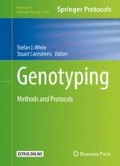Abstract
A major goal for biologists is to understand the connection between genes and phenotypic traits, and genetic mapping in experimental populations remains a powerful approach for discovering the causal genes underlying phenotypes. For genetic mapping, the process of genotyping was previously a major rate-limiting step. Modern sequencing technology has greatly improved the resolution and speed of genetic mapping by reducing the time, labor, and cost per genotyping marker. In addition, the ability to perform genotyping-by-sequencing (GBS) has facilitated large-scale population genetic analyses by providing a simpler way to survey segregating genetic variation in natural populations. Here we present two protocols for GBS, using the Illumina platform, that can be applied to a wide range of genotyping projects in different species. The first protocol is for genotyping a subset of marker positions genome-wide using restriction digestion, and the second is for preparing inexpensive paired-end whole-genome libraries. We discuss the suitability of each approach for different genotyping applications and provide notes for adapting these protocols for use with a liquid-handling robot.
Access this chapter
Tax calculation will be finalised at checkout
Purchases are for personal use only
References
Baird NA, Etter PD, Atwood TS et al (2008) Rapid SNP discovery and genetic mapping using sequenced RAD markers. PLoS One 3:e3376
Monson-Miller J, Sanchez-Mendez DC, Fass J et al (2012) Reference genome-independent assessment of mutation density using restriction enzyme-phased sequencing. BMC Genomics 13:72
Cao J, Schneeberger K, Ossowski S et al (2011) Whole-genome sequencing of multiple Arabidopsis thaliana populations. Nat Genet 43:956–963
Rowan BA, Patel V, Weigel D et al (2015) Rapid and inexpensive whole-genome genotyping-by-sequencing for crossover localization and fine-scale genetic mapping. G3 5:385–398
Rohland N, Reich D (2012) Cost-effective, high-throughput DNA sequencing libraries for multiplexed target capture. Genome Res 22:939–946
Acknowledgements
We thank Paulo Teixeira for sharing his modifications of the Rohland and Reich (2012) protocol for preparing the Serapure SPRI beads, and George Wang for analyzing the index sequences for the 96 whole genome adapters and indexing primers to determine optimal base balance. We also acknowledge Norman Warthmann for designing the indexing primers.
Author information
Authors and Affiliations
Corresponding author
Editor information
Editors and Affiliations
1 Electronic Supplementary Material
Below is the link to the electronic supplementary material.
Supplementary Table 1
Oligo sequences for 384 KpnI adapters and primers (XLSX 74 kb)
Supplementary Table 2
Oligo sequences for 96 indexed P1 adapters and Universal P2 adapter If pooling fewer than 96 samples at a time, arrange the adapters in a 96-well plate according to the “Well” column and pool samples column-wise from column 1 through column 12. The 3′ phosphorothioate (PTO) modification is between the last two bases of the oligo. (XLSX 17 kb)
Supplementary Table 3
Oligo sequences for PCR indexing of 96-plexes. The order column provides the optimal order for pooling 96-plexes. It is recommended to use at least four of these indices in a single lane. All oligos have a 3′phosphorothioate (PTO) modification between the last two bases of the oligo. (XLSX 39 kb)
Rights and permissions
Copyright information
© 2017 Springer Science+Business Media New York
About this protocol
Cite this protocol
Rowan, B.A., Seymour, D.K., Chae, E., Lundberg, D.S., Weigel, D. (2017). Methods for Genotyping-by-Sequencing. In: White, S., Cantsilieris, S. (eds) Genotyping. Methods in Molecular Biology, vol 1492. Humana Press, New York, NY. https://doi.org/10.1007/978-1-4939-6442-0_16
Download citation
DOI: https://doi.org/10.1007/978-1-4939-6442-0_16
Published:
Publisher Name: Humana Press, New York, NY
Print ISBN: 978-1-4939-6440-6
Online ISBN: 978-1-4939-6442-0
eBook Packages: Springer Protocols

